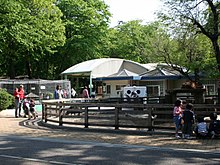Inokashira Park Zoo
| Inokashira Park Zoo | |
|---|---|
 Inokashira Park Zoo | |
 | |
| 35°42′2.999″N 139°34′21.900″E / 35.70083306°N 139.57275000°E | |
| Date opened | 1942 |
| Memberships | JAZA[1] |
| Website | www |
Inokashira Park Zoo (Japanese: いのかしらしぜんぶんかえん; Kanji:
History
[edit]In September 1905, Shibusawa Eiichi borrowed a corner of Inokashira Gotenyama Garden from the imperial family and founded the Tokyo Maternity Hospital Conversion Division (later Inokashira School) to accommodate juvenile delinquents.[3] On May 1, 1917, the entire town was granted to Tokyo and Inokashira Park was opened. On May 5, 1934, "Nakanoshima small animal zoo" opened at the current branch location.[4]
In 1939, when the Inokashira school relocated, the plan to build a big zoo in this area was advanced. Initially it was conceived as "a big zoo" comparable to the Ueno Zoo, but due to the wartime budget and supplies shortage, large animals can not be gathered. The plan changed to a "nature observation park". It opened on May 17, 1942.[4]
Two giraffes were bred at the time of the opening, but both died by the end of the war.[4]
Overview
[edit]In 2006, to reduce the risk of breeding, the Ministry of the Environment moved some endangered Tsushima leopard cats to the zoo. Breeding restarted on February 22, 2008.[5][6]
It is divided into a main zoo in Gotenyama, Musashino and a branch location in Inokashira, Mitaka. In the main park, mainly mammals and birds are raised, and waterfowl are kept in the garden surrounded by Inokashira pond. Also, there is a cultural museum, where special exhibitions and lectures or meetings are held.[7] There was also a "tropical bird greenhouse", but on June 2, 2013, it closed due to its age.[8] There is an aquarium with fish and amphibians in the secondary park.
A sculpture garden is in one corner of the park with works by Seibo Kitamura.[9][10] In addition, a small amusement park (a merry-go round, teacups, train) is in another corner of the park.[11]
Animals
[edit]
The zoo displays 170 animal species focusing on native species and a few exotic species.
- Main Park
- Barn owl
- Capybara
- Copper pheasant
- Crested porcupine
- Eurasian otter
- Fennec fox
- Guinea pig
- Humboldt penguin
- Japanese green woodpecker
- Japanese marten
- Japanese scops owl
- Japanese serow
- Japanese sparrowhawk
- Japanese squirrel
- Japanese wood pigeon
- Leopard cat
- Masked palm civet
- Meerkat
- Patagonian mara
- Rhesus macaque
- Ryukyu flying fox
- Sika deer
- Wild boar
- Aquatic Life Park
- Black-faced spoonbill
- Call duck
- Grey heron
- Japanese fire-bellied newt
- Japanese giant salamander
- Japanese night heron
- Japanese rice fish
- Lesser white-fronted goose
- Mandarin duck
- Musashi ninespine stickleback
- Oriental stork
- Tokyo bitterling
- Whooper swan
Hanako
[edit]
Hanako (1947–2016) was a female Asian elephant that was kept the zoo. She was born in Thailand in 1947 and came to Japan for the first time after the war, gifted to Ueno Zoo in 1949. She inherited the name of the elephant "Hanako (Wanry)" who was starved to death during the war. Hanako toured the whole country and Tokyo under the Ueno Zoo's "Mobile Zoo" project that began in 1950 and visited Inokashira Natural Culture Park for three consecutive years. On 5 March 1954 she was moved to Inokashira Park Zoo from Ueno Zoo.[12][13]
In 1956, she stepped on and killed a man who was inebriated and trespassing before the garden opened.[14] In 1960 she stepped on and killed a male keeper.[15]
Her lower left teeth fell out in the 1980s, so she has been fed with a liquid diet consisting of banana and apple. In 2013, Hanako broke the longevity record of elephants raised in Japan.[16] On May 26, 2016, she died at the age of 69.[17]
References
[edit]- ^ "
加盟 園 館 検索 ".日本動物園水族館協会 (in Japanese).[permanent dead link] - ^ "
井 の頭 自然 文化 園 の歴史 |井 の頭 自然 文化 園 公式 サイト -東京 ズーネット". www.tokyo-zoo.net (in Japanese). Retrieved 2018-11-27. - ^ Laboratory, K Creative. "
明治 後期 に高 まる「郊外 型 公園 」への機運 -桜草 数寄 (Sakuraso House)". sakuraso.jp (in Japanese). Retrieved 2018-11-27. - ^ a b c
井 の頭 自然 文化 園 50年 の歩 みと将来 .武蔵野 :東京 都 建設 局 西部 公園 緑地 事務所 . 1992. - ^ "
第 1回 絶滅 危惧 種 ツシマヤマネコに会 ってみた" (in Japanese). Retrieved 2018-11-27. - ^ "
井 の頭 自然 文化 園 :「ヤマネコ祭 」29・30日 開催 …東京 -毎日新聞 ".毎日新聞 (in Japanese). Retrieved 2018-11-27. - ^ "
井 の頭 自然 文化 園 で「大人 のための動物 園 ・水 族 園 講座 」 ゆったり学 び楽 しむ".吉祥寺 経済 新聞 (in Japanese). Retrieved 2018-11-27. - ^ "
熱帯 鳥 温室 の取 り壊 し工事 開始 のお知 らせと、飼育 されていた動物 たちの移動 先 について".東京 ズーネット TOKYO ZOO NET (in Japanese). Retrieved 2018-11-27. - ^ "
動物 が生 き生 き暮 らす「井 の頭 自然 文化 園 」親子 向 けエリア紹介 | いこレポ". report.iko-yo.net (in Japanese). Retrieved 2018-11-27. - ^
日本経済新聞社 ・日経 BP社 . "東京 ・武蔵野 、三鷹 昭和 史 、文人 に思 いはせる四季 の移 ろい、自 …|フード・レストラン|NIKKEI STYLE". NIKKEI STYLE (in Japanese). Retrieved 2018-11-27. - ^ "「こどもの
日 」都内 の入園 無料 スポット11選 !遊 園地 &動物 園 も | いこレポ". report.iko-yo.net (in Japanese). Retrieved 2018-11-27. - ^ "はな
子 が去 って、まもなく2年 ...井 の頭 自然 文化 園 の「ゾウ舎 」特別 開放 ". ニコニコニュース (in Japanese). Retrieved 2018-11-27. - ^ "
三鷹 市 |井 の頭 自然 文化 園 のアジアゾウ「はな子 」に感謝 状 を贈呈 します". 2013-04-14. Archived from the original on 2013-04-14. Retrieved 2018-11-27. - ^ "
父 の生 き方 は象 のはな子 がみんな教 えてくれた". オピニオンサイト「iRONNA(いろんな)」 (in Japanese). Retrieved 2018-11-27. - ^ "asahi.com(
朝日新聞社 ):「はな子 」お世話 、今後 は柵 越 しだゾウ飼育 事故 多発 で -社会 ". 2011-09-24. Archived from the original on 2011-09-24. Retrieved 2018-11-27. - ^ "アジアゾウ「はな
子 」、日本 新 記録 !!".東京 ズーネット TOKYO ZOO NET (in Japanese). Retrieved 2018-11-27. - ^ "ゾウ:
国内 最 高齢 「はな子 」死 ぬ69歳 井 の頭 自然 文化 園 -毎日新聞 ".毎日新聞 (in Japanese). Retrieved 2018-11-27.
